- Retour accueil
- Vous êtes ici : Blog The Pyramids of the Cold v2 The Pyramids of the Cold Section 28 • The scarab amulet glorifications of the hauling Beetle
The Pyramids of the Cold Section 28 • The scarab amulet glorifications of the hauling Beetle
Publié par Bruno Coursol dans The Pyramids of the Cold v2 le 13/05/2023 à 18:51

Pectoral of Tutankhamun with the Winged Scarab, thanks to http://www.globalegyptianmuseum.org/detail.aspx?id=14836
The Pyramids of the Cold v2 (May 2023) • Part D: the Grand Gallery of the Great Pyramid
Section 28 • The scarab amulet glorifications of the Hauling Beetle
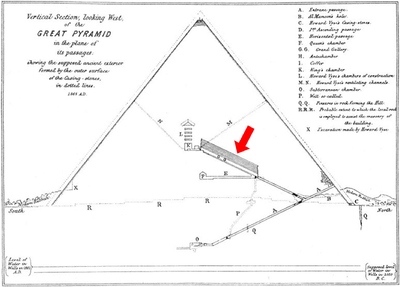
In summary: ancient Egyptian amulets in the form of beetle scarabs are glorifying representations of the Hauling Beetle of the Great Pyramid of Giza. The same way the Hauling Beetle was giving life to the pyramid, the scarab amulets were placed on the bodies of deceased people because they would have been able to give life back to them.
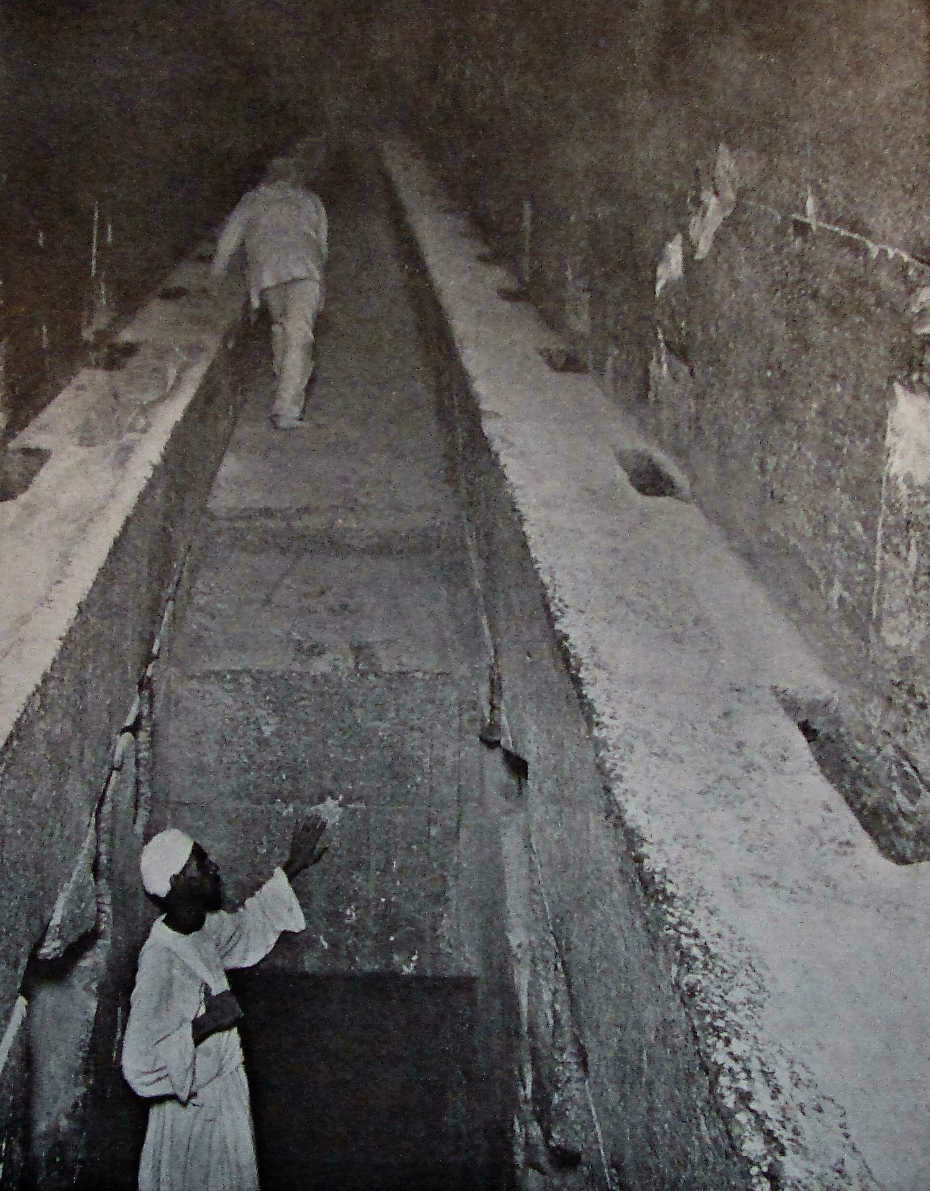
The Grand Gallery of the Great Pyramid of Gizeh, looking south, the sheer-cut-off of the floor; and the two ramps ascending into the darkness beyond. Great Pyramid Passages Volume 1, 1910 edition by John and Morton Edgar: https://archive.org/details/GreatPyramidPassagesVol11910Edition/page/n301/mode/1up

28.01 The similarities between the hauling Beetle and the beetle scarab
At the beginning of my study on the Great Pyramid of Giza, I imagined a wooden gantry that was operated inside the Grand Gallery: the Beetle. That Beetle was in charge of constantly lifting an impactor, in order to create cold inside the horizontal passage and store it inside the Queen's chamber, most probably to be used through its shafts for cooling down chemical reactions for the manufacturing of sodium carbonate, the pure mineral form of natron, the salt used for the mummification of pharaohs.
I called that wooden gantry "the Beetle", because I thought it would have looked exactly like a real beetle scarab: the gantry had to be operated backwards, like a scarab rolling his ball of dung.
But it was nothing serious at the time, it was just based on look-alike elements and I didn't think at all about the scarab amulets.
Since I started to work on the ancient Egyptian scarab amulets though, I had to change my mind on the subject, because it really turns out that the scarab amulets are referring to the wooden Beetle of the Great Pyramid of Giza.

Ancient Egyptian scarab amulets showing on their lower part the 3 ropes that were operated by the hauling Beetle, the wooden gantry that the amulets are referring to.
28.02 The first key element about the scarab animal is that it is moving the dung ball backwards
The Great Pyramid of Giza was a master piece of engineering and it would have made a lot of noise and would have appeared like a living animal. And what gave life to it, was the working crew inside the Grand Gallery, operating the Hauling Beetle.
To pull the impactor upwards, the hauling Beetle crewmembers had to move backwards, because it is the position where you can give the maximum power, like you do when you are playing with a tug of war rope.
Because the Beetle gave life to the pyramid, and because the crewmembers were moving backwards, the whole thing would have looked like a giant scarab moving his dung ball, backwards; the crewmembers looking like the scarab legs.
The important thing here, with the scarab, is not the dung ball he is rolling, but the fact that he is rolling it backwards. To my knowledge, the scarab is the only living animal moving backwards.
If you want to compare the operating of the wooden gantry to an animal, then you have no other choice than use the scarab.
28.03 The second key element about the amulet are the 3 little parallel brown segments
If you look attentively to some of the scarab amulets, the complete ones, we can see 3 short and parallel brown lines on the lower part of the amulets. They are representing the 3 ropes that were attached to the wooden gantry Hauling Beetle. What is very interesting to point out is the color used for the 3 short segments, because in pretty much every scarab amulet, the colors are golden or vivid yellows, blues, greens and reds, but these segments are in a dull brownish color. That doesn't fit at all with the prettiness of the entire amulet.
But of course, if these 3 lines are representations of 3 natural fiber ropes, then it works. The brown color of the 3 short segments is exactly the color of a natural fiber rope.

Mummy Bead Net with Winged Scarab, Third Intermediate Period - Late Period, date 1076-332 BCE, at the Michael C. Carlos Museum in Atlanta: https://collections.carlos.emory.edu/objects/38469/mummy-bead-net-with-winged-scarab
Image from the Walters Art Museum: https://art.thewalters.org/detail/28885/amuletic-figure-of-kebehsenuef-son-of-horus/#item-modal
Faience pectoral scarab with spread wings and bead net, Royal Pump Room, Harrogate. This file was donated by Harrogate Museums and Arts service as part of the Yorkshire: https://en.wikipedia.org/wiki/Scarab_(artifact)#/media/File:Bead_net_with_scarab_HARGM3698.JPG
Egyptian Faience at the Australian Museum, Sydney: https://australian.museum/learn/cultures/international-collection/ancient-egyptian/egyptian-faience/
28.04 The real meaning of the scarab amulet wings
We can try to give an explanation to these deployed wings, but maybe there is more than just one right.
If we look at the hauling process from the impactor point of view, nobody was touching it and it would have looked like it was flying. Thus, it would explain why some scarab amulets are represented with fully deployed wings.

Group of Egyptian scarab amulet carvings. Thanks to AuctionZip.com
28.05 Why so many scarab amulets have a complete longitudinal drilled hole
Most ancient Egyptian scarabs were suspended from string, and wires or mounted in swivel rings; so they were drilled along their longitudinal axis.
This feature is probably unique among traditional Egyptian amulets : the hole, most of the time half drilled from the top and half drilled from the bottom, crosses the entire length of the amulet and replicate the original scarab operation of the Great Pyramid that was passing over the central gutter of the grand gallery.
28.06 The academic explanation of the dung ball representing the Sun God Khepri
It will always baffle me that any people would accept the idea that a god, Sun god Ra Khepri, would be please to know that he is compared to a dung ball, like many people claim the meaning of the scarab is. I wouldn't like to be compared to a dung ball and you certainly wouldn't like it as well. Chances are Ra wouldn't have liked it very much.
28.07 The symbolism of the scarab amulets: giving life back
The scarab amulets are referring to the operating of the Grand Gallery of the Great Pyramid of Khufu, the same way that the Dendera Light bulbs are referring to the horizontal cooling passage of that same pyramid.
The wooden gantry hauling Beetle of the Grand Gallery looked like and behaved like a scarab because it was moving backwards. It made the Great Pyramid alive, and so the scarab amulets, that refer to that hauling Beetle, would give life back to the deceased persons.
The hauling Beetle was the heart of the Great Pyramid, and the scarab amulets had to be placed where the heart would be for the afterlife to be possible in order to make the mummification process successful.
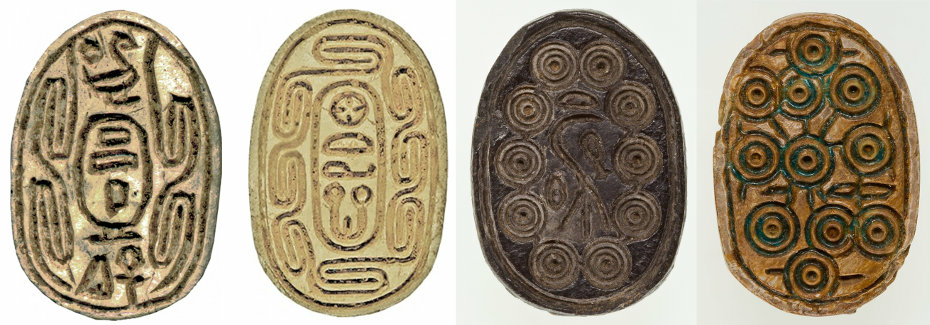
Photographs thanks to the Walters Art Museum, Baltimore USA : 1, 2, 3 4
28.08 Are the underneath decorations of the scarab amulets referring to the hauling Beetle crewmembers?
One of the many interesting things about the scarab amulets, is that they have all kinds of markings underneath them. Sometimes there are some hieroglyphs and sometimes there are only puzzling geometrical markings, like circles, buckles or scrolls.
The problem is that there is absolutely no consistency at all in the numbers in which these markings are appearing: there could be for example 4, 8, 9, 10 or 11 of these markings on each amulet.
There is one possibility which would explain them all, but it might as well be a wrong explanation of the markings.
The idea is that over time, a vast amount of wooden hauling beetles, with probably many different designs, would have been used for the construction of the pyramids or any other kind of construction or technological experiments.
The hauling Beetle of the Grand Gallery was certainly not the only Beetle to be used into, onto or around the Pyramid. The Beetle of the Gallery was made of two separate units (one on the eastern ramp, the other on the western ramp), but there could have been Hauling beetles with only one, or more than two units. There could have been also less or more than three crewmembers per unit like it was in the Beetle of the Gallery.

9 prisoners scarab amulet; the Walters Art Museum, 1330-1213 BCE (New Kingdom, Dynasty 18): https://art.thewalters.org/detail/3485/
28.09 Were the crewmembers of the hauling Beetle captive prisoners?
On the above image of a scarab amulet, there are 9 characters depicted. The conventional interpretation is that these characters are prisoners, with their hands tied up behind their backs. But then there is a problem, because if these 9 characters are referring to a certain type of hauling Beetle that would have been operated by 9 crewmembers and that they would be prisoners, would that mean that the hauling Beetle of the Grand Gallery, was also operated by prisoners?
Also, would ancient Egyptians have carved prisoner representations onto such important amulets?
Or is it just another metaphor? Do these characters appear as prisoners with their hands tied behind their backs because they were simply moving backwards?
But of course, the hypothesis that the base of scarab amulets are carved with glorifications of hauling beetle's crewmembers (some of them about the hauling Beetle of the Grand Gallery and some about other Beetles), could be simply totally wrong.
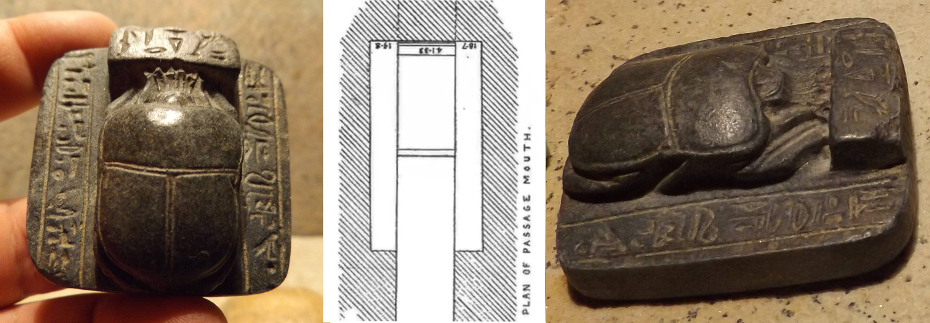
Special thanks to Kameron, from downunderpharaoh.com for the use of his photographs of the squared scarab amulet. In the center, the "plan of passage mouth", from the "trial passages" tunnels of the Great Pyramid of Khufu at Giza.
28.10 The The scarab amulet in a squared shape set replica of the grand gallery
That particular squared shape make this scarab amulet very special, because it probably puts the scarab within the exact layout of the grand gallery of the Great Pyramid of Khufu.
The 2 lateral ramps of the grand gallery are 1 cubit width and the central gutter is 2 cubits width; and these proportions are exactly the same as the ones we find on this squared amulet.
The scarab is most probably represented at the bottom of the grand gallery. There are of course 2 exceptions to the realistic design of this amulet: the wooden scarab wasn't inside the gutter but on both sides of it, moving onto the 2 lateral ramps ; and there was no block in the middle of the gutter either.
Probably, that the transversal block with the hieroglyphs in front of the scarab beetle, stands for the north wall of the gallery, where the wooden beetle would have to rest after its descent in order to get ready to climb up again the slope.
Another thing is that this amulet could confirm the idea I got from the Tutankhamun Senet game table, that the wooden scarab of the gallery wasn't just a unique structure with 2 sledge runners, one against each wall, but 2 narrow structures like the Senet game table. That would mean there was 4 sledge runners for the hauling Beetle alone.
Even if these 2 hauling beetles probably wouldn't even have to be linked together (they would have been completely independent), it is certainly most realistic that they were indeed linked to produce a single unique and solid wooden gantry.
Anyway, on that squared scarab, we can notice that the 2 lateral parts are marked with 2 vertical and parallel straight lines, framing the hieroglyphs and that the hieroglyphs of the top horizontal part have no line at all to frame them.
These 4 vertical lines could be a reference to the 4 hollow-section rails of the Grand Gallery's lateral ramps.
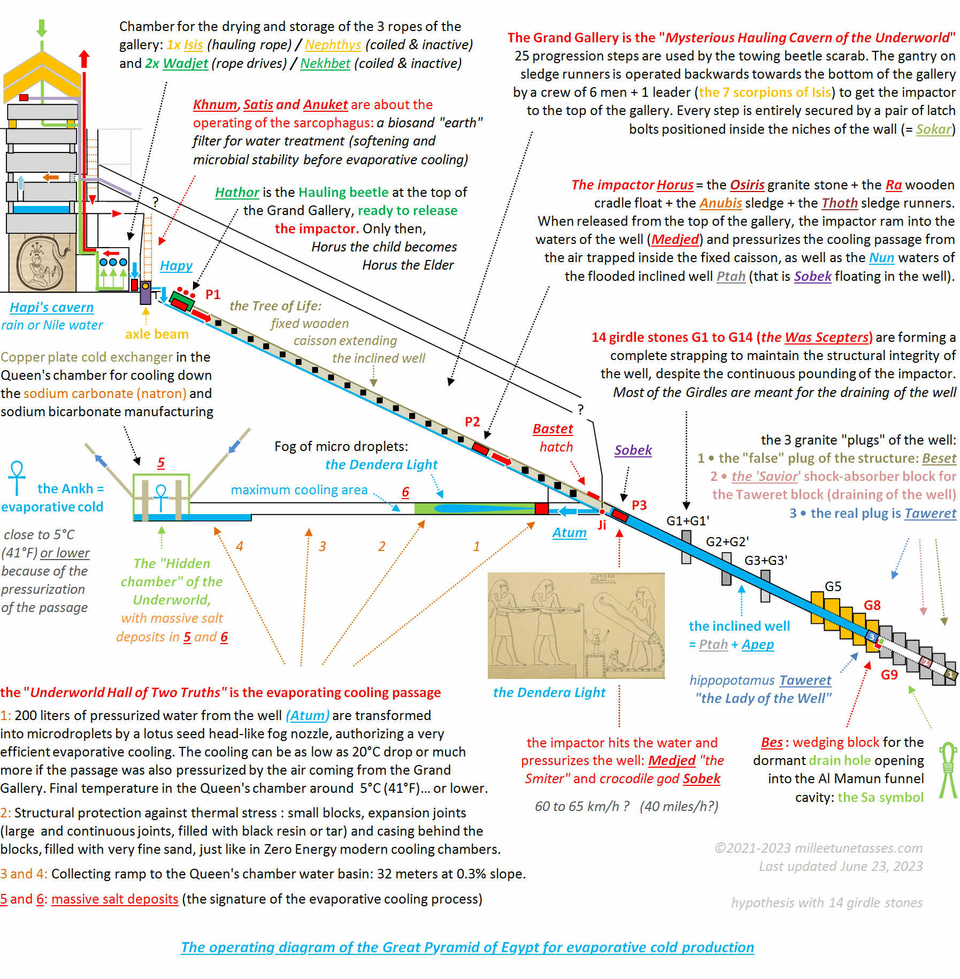
Diagram of the operating Great Pyramid of Egypt for evaporative cold production (hypothetically for chemical manufacturing cooling of pure sodium carbonate "natron", the salt used for the mummification of pharaohs). When in operation, the elevation of the Great Pyramid was not finished, and it is only after the shutdown procedure and the draining of the inclined well, that the 3 granite plugs were finally close to one another.

The Pyramids of the Cold version 2 (May 2023 - March 2024)
Summary of the study and Table of Contents
Part A: The evaporative cooling process
Section 1 • The horizontal evaporative cooling passage layout
Section 2 • The Dendera Light and the creation of the fog of microdroplets by the fog nozzle
Section 3 • The water cycle glorifying metaphors: Geb, Shu, Nut, Tefnut
Section 4 • The theorization of the evaporative cooling process by Akhenaten and Nefertiti
Section 5 • The theorization of the evaporative cooling process in the Weighing of the Heart
Part B • The inclined well of the Great Pyramid of Giza
Section 6 • The inclined well layout and the girdle stones
Section 7 • The Taweret "Lady of the Well" temporary sealing granite plug of the well
Section 8 • The Bes temporary wedging block immobilizing Taweret
Section 9 • The draining of the well
Section 10 • The Great Serpent Apep and the snake water metaphors
Section 11 • The Was scepter and the control over "snakes"
Section 12 • The beating Heart of the Great Pyramid
Part C • The composite impactor of the Great Pyramid (Horus, Ra, Osiris, Medjed, Sobek...)
Section 13 • The wooden and stone composite design of the impactor: Ra and Osiris
Section 14 • The endlessly immersed Osiris stone and the seed metaphor
Section 15 • The Anubis sledge and the bobsled mask
Section 16 • The sledge runners of the impactor: Thoth
Section 17 • Medjed: the smiter nobody can ever see
Section 18 • The Apis bull and the ramming impactor's metaphors
Section 19 • The crocodile god Sobek impactor (more or less) floating in the waters of the well
Section 20 • The Obelisk and the Benben stone rising from water
Part D • The Grand Gallery's of the Great Pyramid of Giza
Section 21 • The Sacred "sloping paths" of the "oval-shaped cavern of the act of Hauling"
Section 22 • The central wooden caisson of the Gallery: Sekhmet and the Triad of Memphis
Section 23 • The hauling ropes of the Grand Gallery: Isis, Nephthys, Hatmehit, Wadjet and Nekhbet
Section 24 • The hauling Beetle and the Seven Scorpions of Isis
Section 25 • The Great Cow goddess Hathor and the operating cycle of the hauling Beetle
Section 26 • The 10 operating phases of the Grand Gallery
Section 27 • The guide to the Afterlife for the smart traveler and the canopic jars
Section 28 • The scarab amulet glorifications of the hauling Beetle
Part E • The very large and roughly finished sarcophagus of the Great Pyramid
Section 29 • The biosand filter sarcophagus of the Great Pyramid
Section 30 • The Elephantine Triad deification of the biosand filter of the Great Pyramid
Section 31 • The Great Pyramid's operating flat roof and the water supply issue
Part F • Chemical manufacturing and industrial cooling before the Great Pyramid
Section 32 • The Serdab and the "Refreshment of the Gods" Step Pyramid of Djoser
Section 33 • Sneferu's Red Pyramid and the accumulated ammonia
Section 34 • The Disc of Sabu and the Solvay process for pure natron manufacturing
Part G • The tremendous impact of the Great Pyramid on the whole ancient world
Section 35 • The hidden secrets of the Hermetica Emerald Tablet (around 1600 C.E.)
Section 36 • Thor and the magical Hammer in the Great Hall of Bilskirnir
Section 37 • The Churning of the waters of the Ocean of Milk (Hindu mythology)
Section 38 • The Tibetan prayer wheels and the Grand Gallery's operation
Section 39 and Conclusion • The cooling water of spitting Kebechet
Part H • Epilogue
Section 40 • The smiting Ark of the Covenant and the Ten Commandments
Section 41 • The 293 kilograms windlass Staff of Moses and Aaron... and the First Plague of Egypt: water turning into blood
Section 42 • Ezekiel's Four Egyptian pulley "Wheels within the Wheels" and the four angel ropes
Section 43 • David, Saul, two giant Goliaths, five little stones, an aeolian harp... and a weaver's beam
Section 44 • The holy water fonts and the biosand filter
Part I • The magicians of the Great Pyramid of Giza
Section 45 • The Legend of Khufu and the "magician" polymath Imhotep
Section 46 • The two magical eyes of Isis and the brilliant but painful flame of her twin sister's braids
Poster un commentaire
